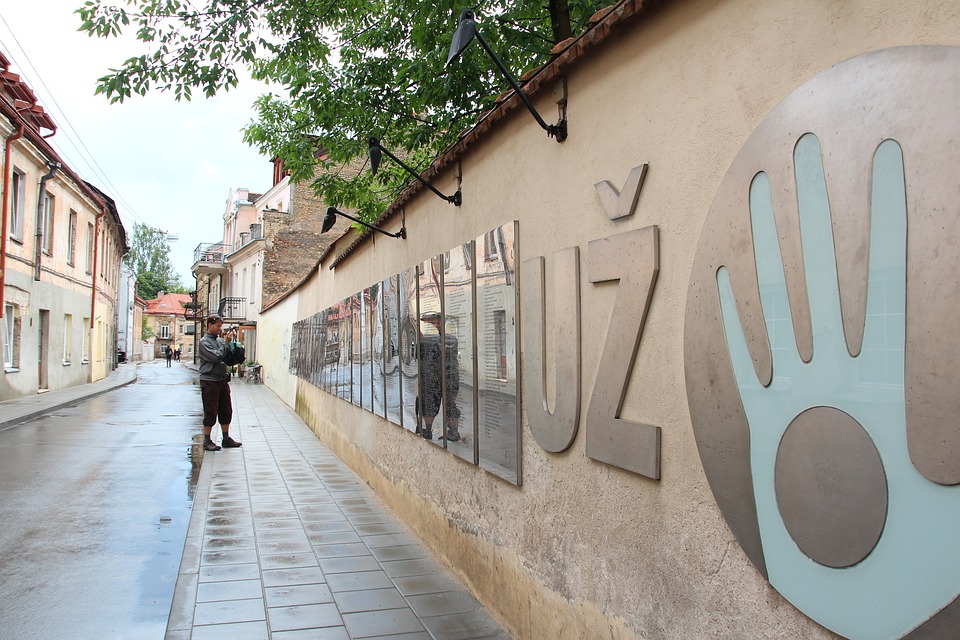One of the most popular streets in Vilnius is Pilies Street, which features a variety of artisans, cafes and street side art markets. If you're looking for locally made paintings or jewelry, spend plenty of time here.
For the more bohemian, hipster cultural neighborhood, visit Uzupis. Known as the "free thinking neighborhood," this republic operates by it's own constitution and was created on April fools Day in 1997. Wanderers will certainly discover vegan cafes, bookstores, art galleries, tons of graffiti and boutique shops. The neighborhood now homes over seven thousand residents, most of which are artists, intellects and musicians, and once homed the Jewish community prior to the Holocaust.
Most people don't realize that the full name of this church is, "'Church of St Johns, St John the Baptist and St John the Apostle and Evangelist." Founded in 1387, this structure stood for hundreds of years before the construction of the 16th Century university. The freestanding campanile is the tallest structure in Vilnius, which features an awe-inspiring view of the city scape and pink rooftops scattered throughout Old Town. The surrounding university is known as the oldest university in Eastern Europe.
Vilnius in total has 28 churches, some of which are no longer in operation. If you have kilometers to burn, walk the Calvary Way, a pilgrimage dedicated to the suffering of Christ.
This is one of the more popular historical and tourist attractions, and for good reason, it is another popular lookout spot to see Vilnius from a bird's eye view.
The Grand Duke of Lithuania, Gedeminas first built this “castle†as a wooden fortifications. In 1409, the Grand Duke Vytautas completed the brick structure, which only remains and a tower still stand today. The tower is a museum exhibiting archaeological finds of Lithuania's past. It's worth the climb, up the hill and tower, for spectacular views of old and new Vilnius.
Nearby the castle and tower is the fertile, lush oasis, Bernadine Garden. Established in 1469 by Bernadine Monks, millions of people have walked this park throughout it's history. Beautiful in all seasons, spring and summer is a surefire way to see locals sachet through the treelined trails. Many people don't realize that the oldest oak tree of Old Town sits in the park. The park also features cafes for guests to sit, sip and relax during the afternoon hours.
​This area once contained many bookstores and antique shops (Literatu, meaning “writers†or “authorsâ€) in the 19th Century, but today are the artistic remains of ceramic, wooden and metal plaques of famous Lithuanian writers. The idea originated in 2008, but showcases some of the best writers and poets in history such as: Sigitas Geda, Kazys Binkis, Romain Gary, Vytautas Kernagis, Janina Degutyte, Jonas Mekas, Jurga Ivanauskaite, Antanas Skema, Paulius Sirvys, and Vincas Mykolaitis – Putinas. ​
Experience a bit of modern Vilnius at the local Cat Cafe. Whether you want a coffee served with a kitty cookie, or lunch, be sure to experience the best of modern cuisine with your new best kitten friend. The cafe features a variety of resident cats you'll find sleeping, playing or begging for treats. This place is vegetarian and vegan friendly.
Graffiti Pier
For another look at modern Vilnius, explore the graffiti around town. Graffiti has no specific location, but most know Graffiti Pier as the main hub to view street art. Here, graffiti is encouraged and legal with the government. Keep updated with the legal painting zones here.
Let's Connect!
This Lemon Tree article is now featured on GPSmyCity. To download this article for offline reading or travel directions to the attractions highlighted in this article, go to Best Cultural Sites and Landmarks in Vilnius, Lithuania.






 RSS Feed
RSS Feed